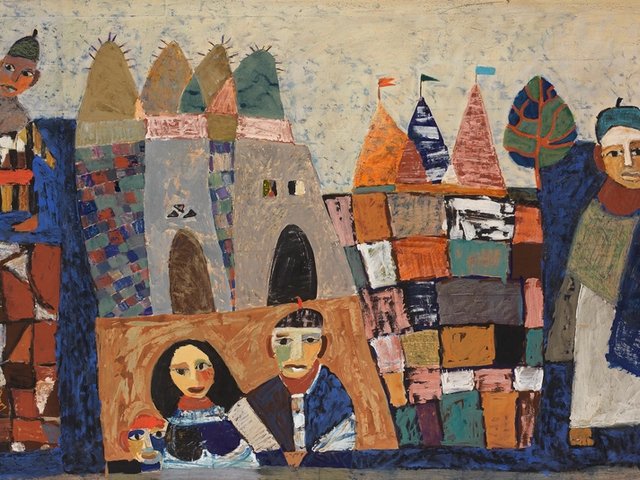This concise study of 50 years of Orientalist art provides a rare account of the careers of individuals and institutions who were bound up by the French imperialist ambitions in North Africa during the Third Republic.
According to Roger Benjamin, focusing on the Modernist era provides a ground not only for repudiating the “standard” claims that “the [Orientalist] movement went into decline” after the 1880s, but also for revitalising Orientalism as a remarkably useful concept for the study of Modernism and its relation to the colonial sphere. Significantly, the author’s discussion of Renoir and Matisse, each receiving a separate chapter, decentres the Modernist narrative, thus restoring Renoir’s little known Algerian works to his rightful place in the histories of Orientalist art, and exposing Matisse as an opportunist who benefited from “colonial policies of government support for Islamic artisanal traditions.” We learn that Renoir received an immediate recognition by contemporary critics and devotees of Orientalism, such as Léonce Bénédite, and that his paintings furnished the exhibitions of the newly founded Society of French Orientalist Painters (1893).
Matisse, on the other hand, cognisant of his own avant-gardism, deliberately isolated himself from the “populist contexts such as that of the Orientalist Painters,” even though his Moroccan pictures shared many characteristics with the Society’s repertory.
Divided into three areas of historical inquiry (though not in any particular order), the book deftly paints a dual-imaged North Africa “both as a paying attraction and a form of propaganda”, closely knit together by a network of institutions and people.
The first section consists of an introduction and analysis of now forgotten 19th-century critiques of Orientalist art by figures such as Fromentin, painter and travel writer, Castagnary, an art critic, and Bénédite, curator of the Luxembourg Museum, among many others.
The second area of enquiry explores the ways in which colonialism enabled cultural tourism and, more officially, the Ministry of the Colonies made the artists’ journey possible in the form of travelling scholarships.
Finally, the third section investigates the institutions, showing how the societies, colonial exhibitions and national museums helped refine the parameters of Orientalist aesthetics and legitimised French cultural imperialism.
Dr Benjamin argues that, rather than being dead and buried Orientalist art, was revitalised through aesthetic debates that were informed by anti-colonialist (Fromentin), patriotic (Castagnary) and colonialist sentiments (Bénédite), a claim which provides the reader with in-depth understanding of the parallels between aesthetics and politics. He posits the same complexity in the reception of travelling artists, best exemplified in the juxtaposition between Gauguin, the Symbolist in Tahiti, and Etienne Dinet, the arch-Realist in Algeria: while they differ hugely on aesthetic grounds, they shared unexamined and unwitting colonial outlooks and assumptions.
This leads to the author’s discussion of exhibitions as colonial propaganda. At the 1931 International Colonial Exhibition at Vincennes, Gauguin’s “nativist” art had become more palatable for colonial tastemakers than Dinet’s, whose conversion to Islam made his art indigestible for such art consumers.
This was the paradox of “colonial cultural network”, which, in the author’s view, “animates the most interesting moments of Orientalism – when French painters ‘went native,’ Algerians ‘went modern,’ and European avant-gardists and conservatives alike opened up to the promptings of aesthetic traditions not their own.” The Algerian landscapist Azouoau Mammeri’s adoption of European style is one of those moments where a native artist’s reputation vacillated between admiration for his home-grown talents and the perils of becoming a European epigone. This is most clearly demonstrated by a discussion of another native artist, Mohammed Racim, whose art, remaining within the scope of colonial civilising mission, became a curious hybrid.
However, in both cases Dr Benjamin sees their work as creative responses to given conditions, even though the curators of the National Museum of Fine Arts of Algiers (established for the Centenary of French Algeria in 1930), had very different evaluations of the artists. While Mammeri hardly qualified for inclusion among the French worthies (one small canvas), Racim’s hybrid work fitted the French notion of native art. (The museum’s curator also rejected Dinet’s paintings.)
Discussions of this kind inaugurated by Dr Benjamin have been thin on the ground in the world Orientalist studies and he has succeeded in bringing to life the dialogic relation between artists, politics, museums, criticism and collecting.
Orientalist aesthetics is a remarkably rich and challenging study of Orientalism in the Modernist and colonial era. The author’s analysis of paintings is certainly impressive, but this informed analysis is hindered by a lack of images throughout. Unfortunately, the book is also less original when tackling such things as concepts of tradition, Islamic attitudes towards images, and his handling of Algerian history is clumsy—there is hardly any mention of the shift from Ottoman to French rule. Could the 300 years of Ottoman heritage be that insignificant for the study of Orientalism?
This book is a major contribution to the study of Orientalism and, having taken the topic beyond the range of the customary academic concerns, it opens up exciting and new avenues for further research.
o Roger Benjamin, Orientalist aesthetics: art, colonialism, and French North Africa, 1880-1930 (University of California Press, Berkeley, 2003), 368 pp, 124 b/w ills, 16 col. ills, £35, $49.95 (hb) ISBN 0520222172
Originally appeared in The Art Newspaper as 'Going native, but not too much'


